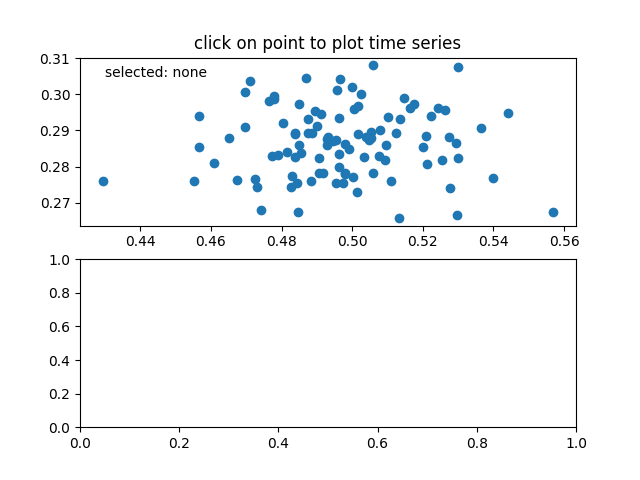Observação
Clique aqui para baixar o código de exemplo completo
Navegador de dados #
Conectando dados entre várias telas.
Este exemplo aborda como interagir dados com várias telas. Isso permite selecionar e destacar um ponto em um eixo e gerar os dados desse ponto no outro eixo.
Observação
Este exemplo exercita os recursos interativos do Matplotlib e isso não aparecerá na documentação estática. Por favor, execute este código em sua máquina para ver a interatividade.
Você pode copiar e colar partes individuais ou baixar o exemplo inteiro usando o link na parte inferior da página.

import numpy as np
class PointBrowser:
"""
Click on a point to select and highlight it -- the data that
generated the point will be shown in the lower axes. Use the 'n'
and 'p' keys to browse through the next and previous points
"""
def __init__(self):
self.lastind = 0
self.text = ax.text(0.05, 0.95, 'selected: none',
transform=ax.transAxes, va='top')
self.selected, = ax.plot([xs[0]], [ys[0]], 'o', ms=12, alpha=0.4,
color='yellow', visible=False)
def on_press(self, event):
if self.lastind is None:
return
if event.key not in ('n', 'p'):
return
if event.key == 'n':
inc = 1
else:
inc = -1
self.lastind += inc
self.lastind = np.clip(self.lastind, 0, len(xs) - 1)
self.update()
def on_pick(self, event):
if event.artist != line:
return True
N = len(event.ind)
if not N:
return True
# the click locations
x = event.mouseevent.xdata
y = event.mouseevent.ydata
distances = np.hypot(x - xs[event.ind], y - ys[event.ind])
indmin = distances.argmin()
dataind = event.ind[indmin]
self.lastind = dataind
self.update()
def update(self):
if self.lastind is None:
return
dataind = self.lastind
ax2.clear()
ax2.plot(X[dataind])
ax2.text(0.05, 0.9, f'mu={xs[dataind]:1.3f}\nsigma={ys[dataind]:1.3f}',
transform=ax2.transAxes, va='top')
ax2.set_ylim(-0.5, 1.5)
self.selected.set_visible(True)
self.selected.set_data(xs[dataind], ys[dataind])
self.text.set_text('selected: %d' % dataind)
fig.canvas.draw()
if __name__ == '__main__':
import matplotlib.pyplot as plt
# Fixing random state for reproducibility
np.random.seed(19680801)
X = np.random.rand(100, 200)
xs = np.mean(X, axis=1)
ys = np.std(X, axis=1)
fig, (ax, ax2) = plt.subplots(2, 1)
ax.set_title('click on point to plot time series')
line, = ax.plot(xs, ys, 'o', picker=True, pickradius=5)
browser = PointBrowser()
fig.canvas.mpl_connect('pick_event', browser.on_pick)
fig.canvas.mpl_connect('key_press_event', browser.on_press)
plt.show()